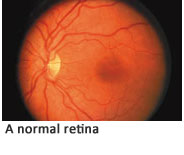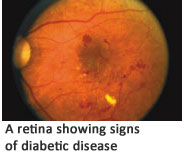What is diabetic retinopathy?
Diabetic retinopathy, the most common diabetic eye disease, is caused by changes in the blood vessels of the retina.
There are two types of diabetic retinopathy:
- Background or nonproliferative diabetic retinopathy (NPDR); and
- Proliferative diabetic retinopathy (PDR)


Nonproliferative diabetic retinopathy (NPDR)
Nonproliferative diabetic retinopathy (NPDR) is the earliest stage of diabetic retinopathy. With this condition, damaged blood vessels in the retina begin to leak extra fluid and small amounts of blood into the eye. Sometimes, deposits of cholesterol or other fats from the blood may leak into the retina. Watch how NPDR affects your eyes.
NPDR can cause changes in the eye, including:
MICROANEURYSMS. Small bulges in blood vessels of the retina that often leak fluid.
Retinal hemorrhages. Tiny spots of blood that leak into the retina (these spots alone are rarely responsible for any loss of vision).
HARD EXUDATES. Deposits of cholesterol or other fats from the blood that have leaked into the retina.
Many people with diabetes have mild NPDR, which usually does not affect their vision. However, if their vision is affected, it is the result of macular edema and macular ischemia. Watch how macular edema and macular ischemia affect your eyes.
MACULAR EDEMA. Swelling or thickening of the macula. It is caused by fluid leaking from the retina’s blood vessels. The macula, which is responsible for our clear, central vision, does not function properly when it is swollen. Macular edema is the most common cause of vision loss in diabetes. Vision loss may be mild to severe, but in many cases, your peripheral (side) vision remains. Laser treatment may help to stabilize vision.
Macular ischemia. Occurs when small blood vessels (capillaries) close. Your vision blurs because the macula no longer receives enough blood to work properly. Currently, there is no effective treatment for macular ischemia.
Proliferative diabetic retinopathy (PDR)
Proliferative diabetic retinopathy (PDR) occurs when abnormal blood vessels begin to grow on the surface of the retina or optic nerve. This is called neovascularization. Watch how PDR affects your eyes. PDR mainly occurs when many of the blood vessels in the retina close, preventing enough blood flow. The retina responds by growing new blood vessels in an attempt to supply the area where the original vessels closed. However, the new blood vessels are abnormal and do not supply the retina with normal blood flow. The new vessels are also often accompanied by scar tissue that may cause the retina to wrinkle or detach. PDR may cause more severe vision loss than NPDR because it can affect both central and peripheral vision.
PDR causes vision loss in the following ways:
VITREOUS HEMORRHAGE. The delicate new blood vessels may bleed into the vitreous — the gel in the center of the eye — preventing light rays from reaching the retina. If the vitreous hemorrhage is small, you may see a few new, dark floaters. A very large hemorrhage might block out all vision, allowing you to perceive only light and dark. Vitreous hemorrhage alone does not cause permanent vision loss. When the blood clears, your vision may return to its former level unless the macula has been damaged.
TRACTIONAL RETINAL DETACHMENT. With PDR, scar tissue from neovascularization can shrink, causing the retina to wrinkle and pull from its normal position. This is called traction retinal detachment. Macular wrinkling can distort your vision. More severe vision loss can occur if the macula or large areas of the retina are detached.
NEOVASCULAR GLAUCOMA. Occasionally, if a number of retinal vessels are closed, neovascularization can occur in the iris (the colored part of the eye). In this condition, the new blood vessels may block the normal flow of fluid out of the eye. Pressure builds up in the eye, resulting in neovascular glaucoma, a particularly severe eye disease that causes damage to the optic nerve.
Diabetes can cause vision in both eyes to change, even if you do not have retinopathy. Rapid changes in your blood sugar alter the shape of your eye’s lens, and the image on the retina will become out of focus. After your blood sugar stabilizes, the image will be back in focus. You can reduce episodes of blurred vision by maintaining good control of your blood sugar.
